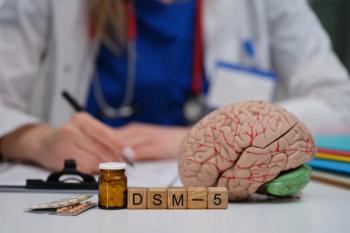
Psychotropic Drugs and Falls in Older Adults
In the elderly, falls are a common and important problem. In the US, fall-related injuries cost approximately $30 billion per year, and about 30% of older adults fall at least once in a given year.
Dr. Lenze is Professor of Psychiatry, Washington University, St Louis, MO.
In the elderly, falls are a common and important problem. In the US, fall-related injuries cost approximately $30 billion per year, and about 30% of older adults fall at least once in a given year.1 One of the most feared consequences of falling is a hip fracture, which occurs in almost 400,000 older adults each year. Other consequences include other fractures, head injuries, and less serious injuries that can nonetheless impair function and quality of life.
Moreover, after a fall-related injury, many older adults can have a fear of falling, a common geriatric condition marked by anxiety and low self-confidence about walking safely. Although not a DSM diagnosis, fear of falling is recognized as a common source of functional impairment and distress (and increased risk of falls) in older adults.2
Falls are highly relevant to psychiatry because they are often preventable, and one of the most highly feasible prevention strategies concerns psychotropic drugs. Simply stated: if we reduce the use of psychotropic drugs that are known to cause falls (or better yet, avoid such drugs in the first place), we will greatly improve our older patients’ quality of life by preventing falls and fall-related injuries.
Case 1: Your patient is a 74-year-old woman who was referred to you by her primary care physician for management of a complicated psychotropic medication regimen. Her family is very concerned about her gait instability. Upon meeting her, you see obvious ataxia, and at times she has to hold on to the wall for support when she walks. She has had 3 falls in the past 6 months, one of which was serious enough to require a visit to the emergency department. Her family wants to know whether her medications increase her risk of falls-and what should be done about them.
How to reduce falls in older psychiatric patients
First, review your patient’s entire list of medications (not just the “psych” drugs) to look for any drugs that are known to cause falls, in order to stop them (or better yet, not to start them in the first place). There are 2 kinds of medication-related problems: the first are individual drugs that increase fall risk; the second are drug interactions that increase fall risk. For both of these, the most common drugs are sedatives, and in particular benzodiazepines. The Table lists commonly used medications in older adults that increase fall risk.
Benzodiazepines
Be aware of the following clinical points about benzodiazepines and falls in older adults:
1 There are no “safe benzos”: all benzodiazepines have fall risk, including short-acting medications such as alprazolam.
2 There’s no therapeutic index for older adults: there is no dose at which benzodiazepines are effective for anxiety disorders yet safe from fall risk.
3 Sedation equals fall risk: a patient who complains of daytime sedation or shows signs of sedation on examination is a patient whose reaction time and postural control are reduced.
4 Risk is dose-related: the higher the dose, the greater the risk of falls. This can be an issue with the highly potent benzodiazepines such as clonazepam. A dosage of clonazepam 1 mg twice daily might not sound like a high dosage to many practitioners, but 1 mg of clonazepam is equal in potency to 2 mg of alprazolam or 4 mg of lorazepam.
Avoid the use of benzodiazepines, especially long-term use. Benzodiazepines initiated in a hospital or consultative setting (eg, the patient is anxious) should have an automatic stop in the order (eg, “stop prescription upon discharge”).
Do not prescribe benzodiazepines in the first place: many safer, effective treatments exist. Since the 2 main reasons for a benzodiazepine prescription are insomnia and anxiety, use behavioral methods as a first-line intervention. Cognitive behavioral therapy, brief behavioral therapy, and sleep hygiene are all good first-line choices for insomnia; cognitive behavioral therapy, relaxation training, and mindfulness training are all effective for chronic anxiety. In addition, both insomnia and anxiety disorders have effective medication regimens that are safer than benzodiazepines: trazodone, ramelteon, and melatonin for insomnia; and SSRIs, SNRIs, and mirtazapine for anxiety.
Taper and try to stop benzodiazepines in older adults, especially in those with obvious fall risk (such as recent falls or ataxia). A good rule of thumb is to go slow: a small dose reduction every 2 weeks should avoid overt withdrawal and more insidious rebound effects.
A final point about reducing and stopping benzodiazepines is to remember that these medications are habit-forming. Clearly describe their risks in ways that patients understand and remember (eg, “this medication causes hip fractures”; “it is bad for your brain, like having Alzheimer’s”). Reiterate these risks, using the same memorable language, at follow-up appointments.
Other fall-inducing medications
Any sedative can cause falls. Aside from benzodiazepines, sleeping medications (particularly the “z-drugs”-zolpidem, zaleplon, and eszopiclone), centrally acting anticholinergics and antihistamines, and some other psychotropic drugs (eg, gabapentin; some antipsychotics) can increase the risk of falls. Many of these drugs are “non-psychiatric” drugs, such as anticholinergics for the bowel or bladder, antihistamines for allergies, and over-the-counter sleep medications such as diphenhydramine. Because these drugs adversely affect the brain, identifying and stopping them is the psychiatrist’s job, as doing so reduces patients’ fall risk, helps their cognitive function, and reduces their risk of delirium and cognitive decline. The centrally acting anticholinergics can often be stopped immediately, or if they are needed, they can be switched to a less toxic alternative. Thus, many of these sedating drugs are easy to fix with a “stop or switch” approach.
This article should not be taken as a recommendation to stop or avoid all fall-risk medications. Indeed, many may be necessary for stabilizing a patient psychiatrically (eg, antipsychotics or mood stabilizers for severe mental illness) or medically (eg, antiseizure medications). This article cannot provide a one-size-fits-all recommendation in such cases; they will be classic “risk versus risk” decisions that consider the risk of a patient falling (or suffering cognitive impairment) against the risk of clinically worsening. In fact, there are scenarios in which patients must receive medications that are hazardous to them; for example, antipsychotics in dementia with behavior disturbance. In such cases, communicate with patients and their families this balance of risks and benefits, and aim for a shared decision-making process.
Polypharmacy can cause falls
Two types of drug combinations are known to cause falls. The first is “cumulative” (or pharmacodynamic) interactions. For example, an older adult who takes 2 sedative drugs is at greater risk for falling than an older adult who takes one (assuming same dose). Remember that some of these hazardous combinations may include something “over the counter” (eg, alcohol plus a sedative medication).
The second drug interaction is pharmacokinetic: one drug interferes with the metabolism of another, raising its concentration and making it toxic. Some antidepressants are notorious for these interactions-namely, paroxetine (strong CYP 2D6 and 2B6 inhibitor), fluoxetine and duloxetine (moderate CYP 2D6 and 2B6 inhibitors), and bupropion (strong CYP 2D6 inhibitor). For example, a common antidepressant combination strategy is paroxetine plus bupropion. This makes sense from a pharmacodynamic perspective, as paroxetine is an SSRI while bupropion is a norepinephrine and a dopamine reuptake inhibitor. But it is a nightmare from a pharmacokinetic perspective: paroxetine inhibits 2D6 (thus, it inhibits its own metabolism, producing non-linear pharmacokinetics) and 2B6, which metabolizes bupropion. Bupropion in turn also inhibits 2D6 (further inhibiting paroxetine’s metabolism). The result can be a positive feedback loop in which the 2 drugs increase each other’s concentration and cause adverse effects, including falls.3 For this reason, it is important to be aware of the pharmacokinetic effects of common psychotropics.
Do commonly prescribed antidepressants cause falls in older adults?
Case 2: Your patient is a 60-year-old woman whom you are treating for recurrent major depression with an SSRI. She has responded well and comes for routine follow-up. However, at this visit, she wants to stop the antidepressant. She says she recently read that antidepressants cause falls in older adults, and she is afraid of falling because she has osteopenia and her mother died of complications of a hip fracture. What should you do?
Several observational studies have reported that antidepressants are associated with falls in older adults. This includes SSRIs and SNRIs. It should also be noted that a host of additional “risks” of these antidepressants have been reported in observational studies, including all-cause mortality, suicide, and bone loss. However, there is no evidence that antidepressants cause falls (or any of these other risks) in older adults, as no randomized controlled trial has demonstrated this association. In spite of the absence of conclusive evidence, some may argue observational studies are sufficient to assert that these antidepressants do cause falls and therefore that clinical practice and policy should reflect this risk. Such a viewpoint might recommend that antidepressants be less commonly used in older adults, perhaps in favor of psychotherapy, and that they be reserved for the most severe acute cases and then be tapered off.
Yet, in medicine, observational studies are typically insufficient to argue causality (with some notable exceptions, such as smoking and lung cancer). Observational studies are insufficient because they cannot rule out alternative explanations for the association. Other explanations for the antidepressant-falls association are that falls cause people to be placed on antidepressants, and that older adults who are prescribed antidepressants in the real world tend to be people who are more fall-prone in the first place-because they are medically ill and functionally impaired (and depressed!). No observational study can completely control for confounding variables.4
A question of antidepressants
Given the unresolved controversy, psychotropics in the elderly are an example of the typical “risk versus risk” consideration that we commonly grapple with in psychiatry; namely, does the risk of treatment outweigh the risk of non-treatment? In older adults, the known risks of untreated major depression and anxiety disorders usually outweigh the unknown risk of falls with antidepressants. This does not mean that antidepressants are completely benign in older adults. Evidence is needed-in the form of large randomized controlled trials-to determine whether antidepressants do or do not cause falls.
One study, Optimizing Outcomes of Treatment-Resistant Depression in Older Adults (OPTIMUM), may provide some answers. OPTIMUM is a large randomized controlled trial of commonly used augmentation and switch options (such as aripiprazole augmentation, or switch to bupropion) for older adults with treatment-resistant depression. OPTIMUM is ongoing, and results will not be available for several years.
What should clinicians do now? As psychiatrists, it is our job to inform patients of known risks of medications (such as tardive dyskinesia with long-term antipsychotic use), not unknown and unproven ones such as falls with antidepressants. At the same time, we can take the following measures to reduce falls in our patients:
• Ask about recent falls: “Have you fallen in the past 6 months?”
• Assess gait stability at in-person visits
• For those with unsteady gait or multiple recent falls, assess for possible causes, particularly those amenable to psychiatric management
Conclusion
As the 2 cases depict, concern about falls is common in geriatric psychiatry, and understanding and mitigating this risk is a core competency for any psychiatrist who sees older adults. We can do much to prevent falls by reducing risky medications, but there is not sufficient evidence to attribute falls to antidepressants as a class.
Dr. Lenze has received research support from National Institutes of Health, FDA, McKnight Brain Research Foundation, Taylor Family Institute for Innovative Psychiatric Research, Center for Brain Research in Mood Disorders, Barnes Jewish Foundation, Takeda, Lundbeck, Janssen, and Alkermes.
Acknowledgments-This article was supported by funding from the National Institutes of Health and the Taylor Family Institute for Innovative Psychiatric Research and Center for Brain Research in Mood Disorders (at Washington University). The funding source(s) had no role in the preparation, review, or approval of the manuscript.
References:
1. Centers for Disease Control and Prevention. Costs of Falls Among Older Adults. August 2016.
2. Iaboni A, Flint AJ. The complex interplay of depression and falls in older adults: a clinical review. Am J Geriatr Psychiatry. 2013;21:484-492.
3. Joo JH, Lenze EJ, Mulsant BH, et al. Risk factors for falls during treatment of late-life depression. J Clin Psychiatry. 2002;63:936-941.
4. Gebara MA, Lipsey KL, Karp JF, et al. Cause or effect? Selective serotonin reuptake inhibitors and falls in older adults: a systematic review. Am J Geriatr Psychiatry. 2015;23:1016-1028.
Newsletter
Receive trusted psychiatric news, expert analysis, and clinical insights — subscribe today to support your practice and your patients.














